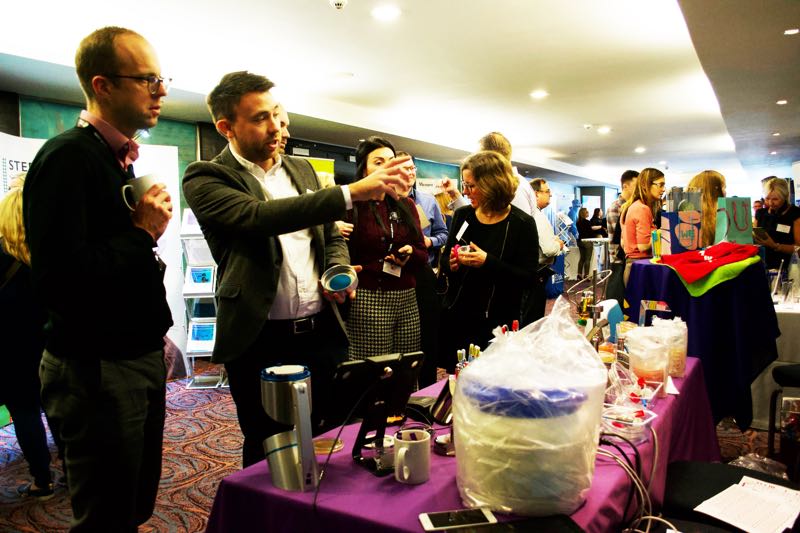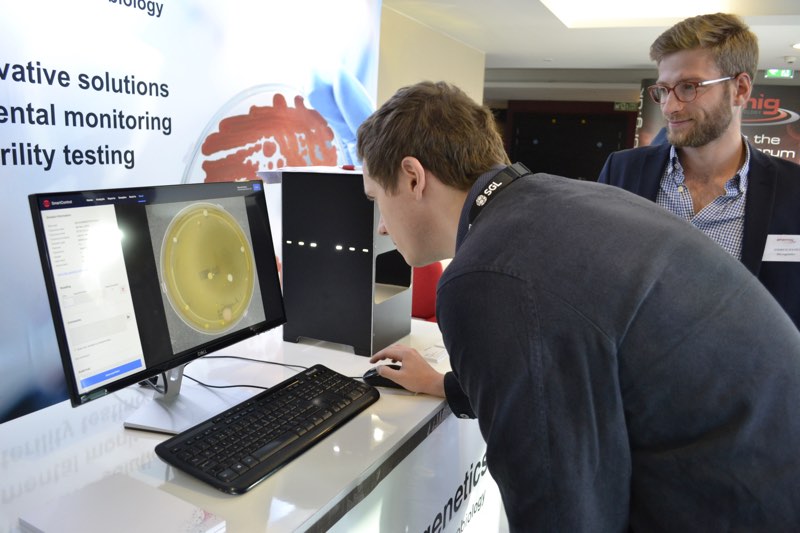“We’re all microbiologists! You sit next to competitors and we all share the experience.” The words of Sharon Hariss of Wickham Laboratories, one of the hundred delegates attending Pharmig’s 27th Annual Conference, is a testament to the event’s success every year.
Held on 13-14 November at the Nottingham Belfry Hotel, the 2019 outing of Pharmig’s gathering brought professionals in the pharmaceutical and healthcare sectors from the UK, Europe and the United States together under one roof to showcase excellence in microbiology.
The exhibition floor was buzzing during the conference break. There were 35 international companies showcasing their best products for sterility testing, microbial colony counts, cleaning and disinfection, and more.
A dedicated mobile app made its debut this year. From the conference agenda to the exhibition floorplan and social wall, every detail was at one’s fingertips. Plus, the speakers answered questions from attendees, entered via the app in real-time, and everyone could take part in polls also generated in the software. Certainly, the app proved to add a fun and interactive twist to the event.
Take-home messages
The conference agenda comprised of a good mix of regulatory-focused talks and hands-on approaches to microbiology theory. The addition of presentations about the pressing issue of sustainability and the part microbiology can play in tackling climate change was inspiring.
The opening presentation by Phil Rose, a GMDP inspector at the UK’s MHRA, reviewed common issues seen at GMP inspections of pharmaceutical facilities. Some of the basics GMP criteria are still being missed, from documentation and data integrity to equipment sterilisation, housekeeping and maintenance.
Rose emphasised that risk assessments should be science-based, and risk prioritisation is a necessary step to allow teams to tackle every issue in a timely manner.
Donald Singer, an accomplished quality leader and Member of the USP Microbiology Expert Committee, described current activities for standard development in chapters <1227> Validation of Microbial Recovery from pharmacopoeial articles; <60> Microbiological Examination of Nonsterile Products; <1071> Rapid Microbial Tests For Release of Sterile Short-Life Products: A Risk-Based Approach; <1085> Guidelines on the Endotoxins Test; and <1229.16> Prion Inactivation.

A USP committee, Singer revealed, is working on a new chapter focusing on tests for Burkholderia Cepacia. The Gram-negative bacteria is responsible “for serious infections in patients with cystic fibrosis, are mechanically ventilated or immunosuppressed or with serious underlying disease”, he said. He returned on day-two with a presentation on raw materials quality with a focus on the client-supplier relationship. His presentation put the spotlight on the role of adequate microbiology control in the supply chain.
Regulatory updates
Pharmig committee member Tim Sandle, Head of Microbiology and Sterility Assurance at Bio Products Laboratory, delivered a round-up of new standards and regulations issued during the past year. He covered the regulatory framework for sterile products and data integrity, and talked about the ISO 21501-4:2018 standard for particle counter calibration, the new ISO 14644- 16:2019 standard for energy efficiency, and the Draft ISO 14644-17 that focuses on deposition rate calculations.
Sandle outlined the latest on medical devices, pharmaceutical-grade water, quality, lab testing and disinfectants. He also commented on the standards that are currently out for public comments, such as the new method based on a recombinant protein factor C (rFC) for the quantification of endotoxins from Gram-negative bacteria, and a fluorimetric end-point detection method.
Regulators are encouraging the industry to adopt currently available technology, from particle and microbial counts to data integrity
Erin Patton of Charles River Laboratories shared her views on the latest revision of Annex 1 and the impacts on EM activities. For Patton, regulators are encouraging the industry to adopt currently available technology, from particle and microbial counts to data integrity.
Commenting on EM data analysis, she encouraged the identification of trending microorganisms, as well as interpreting from these patterns, saying it is fundamental to a contamination control strategy.
Speaking from the US in a conference call, Jeanne Moldenhauer, VP of Excellent Pharma Consulting, outlined the requirements for a contamination control strategy (CCS). She emphasised that quality risk management plays a key part in CCS.
Moldenhauer explained that all regulatory updates point to a holistic approach as best practice and that the CCS should be applied to the entire manufacturing life cycle, from raw material supply, logistics and storage. She emphasised that container-closure security is one of the most challenging issues within the supply chain.
Processes and procedures
Cleaning and disinfection took centre stage in Kim Moorwood’s presentation “Wipe Efficacy Test Methods and Opportunities for Improvements”. The owner of MGS Laboratories described the different efficacy methods and the expected regulatory changes in this field. Moorwood reminded us that a well-done disinfectant qualification provides valuable data on how effective they are in reducing a microbial population.
Mark Hodgson, Process Manager at GSK, talked about the operational challenges in API filling isolators based on the company’s Ulverston site. Focusing on the technology that helps create a sterile workspace in the manufacture of medicinal products, Hodgson pointed out the importance of good measurement and management of H2O2 in controlling temperature and humidity, and glove management.
A well-done disinfectant qualification provides valuable data on how effective they are in reducing a microbial population
The microbial considerations for manufacturing advanced therapy medicinal products (ATMPs) was the focus of Robert Smith’s presentation. The owner of Smiro Qualitas commented on the challenges of working with human cells and tissue, and how to identify the appropriate rapid microbiological methods to use for sterility assurance during ATMP manufacturing.
For Smith, the best way to ensure the quality of the final product is to meet the quality requirements from the outset, ensuring microbial control from the starting material, storage, and distribution to the patient.
On the regulatory front, Smith revealed that the EU Commission has confirmed that Eudralex Vol. 4 Part IV would be the standalone guide for this sector.
Microbiology in action
How accurate is the visual inspection of growth media? Laurent Leblanc, Healthcare Culture Media R&D bioMerieux, asked the audience in his opening presentation on day-two.
Based on real-life data revealed by Form 483 issued by the FDA to companies due to bad practices observed during Petri dishes inspection between 2011 and 2018, Leblanc said that 50% of the main root causes were counting errors, followed by 17% of unreliable data and traceability issues.

Leblanc’s investigation aimed to define a standard for human eye accuracy evaluation, assess the size of objects that can be detected on a Petri dish, determine the level of variability from different operators, and evaluate the enumeration error rate. He emphasised that EM digitalisation currently available on the market boasts real-time enumeration, which provides better accuracy.
Helena Windsor, owner of Mycoplasma Experience, reminds us of the evolution of the mycoplasma testing in the biopharmaceutical industry, and described the differences between test methods required for conventional drug products and ATMPs. She pointed out that it comes down to understanding the risk of working with live human cells.
Sustainability is non-optional
Professor Willy Verstraete of Ghent University explained his disruptive proposition on aerobic microbial protein production in the context of water, food, fertiliser, biodegradable plastics and climate change. For Verstraete, embracing such a process for both animal feed and food is the key to a sustainable future due to its low carbon footprint production method.
Associate Principal Scientist at AstraZeneca, Miriam Guest, put sustainability under the microscope from the perspective of her company. Inspired by AstraZeneca’s commitment to sustainability, Guest talk about what such a concept mean in the lab. With project examples, she pointed out that technology is an ally in this field.
One such example was the AZ Green Lab certification, an initiative run in collaboration with California-based not-for-profit organisation, My Green Lab, aiming to establish a culture of sustainability. In all, Guest emphasised the sustainability agenda is one that should be addressed by looking at “the bigger picture” with fresh ideas and willing to change long-standing behaviours to provide the most meaningful impact on public health.
Pharmig’s committee members are now gathering feedback from exhibitors and attendees, and I’m in no doubt the 28th annual conference will be yet another success.
N.B. This article is featured in the December 2019 issue of Cleanroom Technology. Subscribe today and get your print copy!
The latest digital edition is available online.




